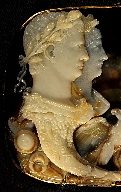Biblical Hebrew is written in consonants only, no vowels, spaces, or punctuation. This provides multiple options for each string of consonants; scribes with competing agendas choose vowels, spaces, and punctuation that best support the preconceived beliefs they want to sell. For example:
Gen 1:1 opens with this string of consonants: BRSTBRLHM… rendered BaReSiT BaRa eLoHiM…, and translated, “In the beginning created God…”
Philo’s Rule 16 for identifying “enigmas”: “Note…the artificial interpretation of a single expression…” Interpreting eLoHiM as “God” is incorrect; in other words, “artificial.” The im suffix creates the plural of eLoaH, the correct Hebrew word for “God.” The consonants LHM create “Gods,” plural.
However, LHM can be correctly rendered LeHeM, “bread,” AND LHM can be correctly rendered eLa Ha eM, “Goddess the Mother” AND “Gods.” But!!! LHM can never be translated “God.” The key to the correct choice is the context or clues dropped nearby.
At Gen 35:9-11, Jacob has a life-changing meeting with LHM (bread? Gods? or Goddess the Mother?) who advises him, “‘Your name is YaaQoB; no longer shall you be called YaaQoB, but Israel shall be your name.’ So he was called Israel. LHM also said to him, ‘I am eL ShaDDaY; be fruitful and multiply; a nation and a company of nations shall come from you, and kings shall come forth from you” (Gen 35:9-11).
LHM has now given a clue to the correct rendering of LHM. LHM says, “I am El ShaDDaY…” The Hebrew word shad is translated “breast.” Later, at Gen 49:25, El Shadday reappears as Jacob lies on his deathbed and blesses his son with Rachel, Joseph: “From eLoaH of your father who helps you, and by Shadday who blesses you with blessings of heaven above, blessings of the deep that lies beneath, blessings of the breasts and the womb.”
Now, this isn’t the first time El Shadday gave a new name to an important biblical character. She had also renamed Ab-ram (translated “Father exalted”); his new name Ab RaHaM means “Father Compassion” (Gen 17:5). And She renamed Sarai (translated “princess”); her new name iSa oRaH means “Woman Light” (Gen 17:15). ISha+oRah+eL is Ishorahel, the etymology of “Israel,” Jacob’s new name and the name of his Tribe, destined to be Kings and Queens.
Gen 35:15: “Jacob named the town where LHM spoke with him BeTeL.” BeT eL is “House of EL.” Adding BT to LHM takes us to BTLHM, the string of Hebrew consonants that create the name of the “little town” from which Jesus came, BeTLeHeM. Next we look for the origin of BeTLeHeM.
Gen 35:19: “So Rachel died, and she was buried on the way to Ephrath (that is BTLHM), and Jacob set up a pillar at her grave, it is the pillar of Rachel’s tomb…Israel journeyed on, and pitched his tent beyond the Migdol Eder (translated, “Watchtower of the Flock”).” Notably, only after Rachel dies is “Jacob” called “Israel.” Why?
The name “Rachel” is derived from Orak Ela, “Spirit of El and/or Ela.” Rachel was also the Spirit of Woman Light (Isha Orah). As long as she lived, Rachel was the Queen of Israel. Upon her death, Jacob assumed the role of King of Israel.
“Pillars” are prominent in Jacob’s story: “Jacob…took the stone that he had put under his head and set it up for a pillar…Jacob made a vow, saying, ‘If LHM will be with me, and will keep me in the Way that I go, and will give me bread to eat … so that I come again to my father’s house in peace, then YHWH shall [not] be bread, and this stone, which I have set up for a pillar, shall be LHM’s house…” (Gen 28:18-22).
Note 1: The Hebrew word translated “The Way” is DRK; rendered aDa OraK, it means “adorned Spirit” and refers to Orak eL, Rachel.
Note 2: The Hebrew consonant L can be rendered eL (“to”), aL (“not”), and/or Li (“my”). It appears in the verses quoted above following YHWH. Judean scribes chose iL (“my”), but Isha Orah’s scribes chose aL (“not”). So, Jacob rejects YHWH in favor of LHM, the Father-Mother God and Goddess, Eloah and Ela Ha Em.
BeTLeHeM did not exist until Rachel died giving birth to her second son whom she named “son of my sorrow.”
BTLHM can also be rendered BeTuLaH eM, “Virgin Mother.” Rachel was a virgin until King Eloah appeared: “Then LHM remembered Rachel, and Eloah heard and opened her womb. She conceived and bore a son…” (Gen 30:22). Rachel gave birth to “Joseph the Nazar.”
Equally important, BTLHM can be rendered BaT eLa Ha eM, translated “Daughter of Goddess the Mother.” Goddess the Mother appears in the very first scene in the Old Testament.
“Goddess” was not a superhuman being. She was the imagined perfect woman with feminine traits: Compassion, Wisdom, Nurturing Love. She was a modifying balance to support and enhance “God’s” ideal masculine traits: Physical Strength, Forcefulness, Aggression. Israelite Kings and Queens, representatives of the balanced Ideal, were called
“Father El” and “Ela the Mother.”
In Old Testament myths, “YaHWeH’s” patriarchal, misogynistic YaHudean Kings waged an ongoing war against Israel’s Kings and Queens. Without the modifying balance of a “Goddess-Queen,” King YaHWeH’s strength, forcefulness, and aggression erupted in acts of violence against children, women and men.
COPYRIGHT 2019, P.J. GOTT, SPRINGFIELD, MO
